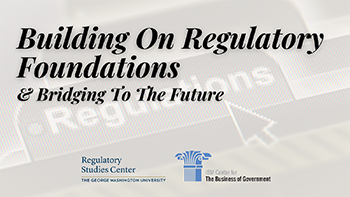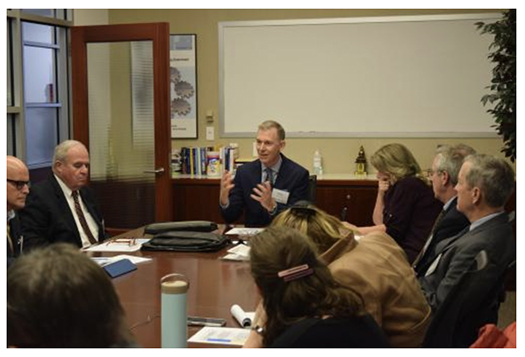
Discussing Agile Regulation

On November 16, 2023, the George Washington University Regulatory Studies Center and the IBM Center for the Business of Government co-hosted an event, Building on Regulatory Foundations and Bridging to the Future, commemorating the 30th anniversary of Executive Order 12866 and 20th anniversary of Circular A-4. Taking place a couple weeks before ChatGPT’s first birthday, the event featured several breakout sessions, including one focused on agile regulation—a framework regulators can use to manage change at speed and scale.
Michael Fitzpatrick, a partner at Brunswick Group, Senior Fellow at ACUS and Fellow at the National Academy of Public Administration (as well as a former OIRA deputy administrator), facilitated the session, which was attended by participants from government agencies, academia, private sector companies, and non-profits. In a world of rapid change, policymakers may have little time to adapt but are expected by market participants to respond quickly. While still a relatively new term, policymakers (including the OECD) increasingly refer to an agile regulation framework, a set of practices and strategies aimed at making regulators more flexible. This could be from agencies using agile processes in their own workflows or from building agility into regulations (e.g., regulatory sandboxes).
 The session used the National Academy of Public Administration’s paper Agile Regulation: A Gateway to the Future, authored by a committee including Fitzpatrick, to launch discussion, with participants offering thoughts to critique or extend on points from the research. While participants discussed a range of potential agency actions, types of improvements roughly fell into three categories: internal processes, substantive design, and continuous learning.
The session used the National Academy of Public Administration’s paper Agile Regulation: A Gateway to the Future, authored by a committee including Fitzpatrick, to launch discussion, with participants offering thoughts to critique or extend on points from the research. While participants discussed a range of potential agency actions, types of improvements roughly fell into three categories: internal processes, substantive design, and continuous learning.
Some participants suggested that agency leaders could foster agile regulation by rewarding innovation among their employees. By highlighting the importance of adaptability and creative thought within trainings and incentivizing innovation in performance evaluations, leaders can signal the importance of these priorities to staff. Other participants noted that small teams often can act more nimbly than larger workforces and wondered if small strike forces focused on fast-moving problems in society could come up with efficient ways to respond. Multi-agency consortia could also share best practices to structure workforces and workstyles in a manner that encourages flexibility without ceding rigor (as well as shared information on newly emerging technologies). While not a major focus of the discussion, the group also discussed the potential of artificial intelligence to enhance agencies’ internal processes. Among other tasks, AI could interpret data, generate or review agency ideas, or survey the corpus of past regulations for retrospective regulation to save staff time.
At the same time, some participants noted that agencies could not be expected to take on more responsibilities or oversight without appropriate resources. To reinvent or reform outdated processes, agencies might need financial support to hire external expertise, and integrating AI or retrospective review into workflows is likely to be costly.
Substantive design refers to how provisions within regulations are written, which can influence the actions regulated entities can take. Improving substantive design could increase agility by enabling market participants to experiment, lower costs, or move with greater speed. This concept, however, led to discussions over whether and how agencies could change how they write rules without ceding authority to regulated entities. Some participants suggested that the relationship between regulator and regulated entity could be rethought, emphasizing partnership to a greater extent. Under this paradigm, agencies might be quicker to use rulemaking processes other than prescriptive or performance-based regulation. In some spheres, agencies have used innovations in substantive design to increase flexibility. Some pointed to the use of adaptive licensing by the Food and Drug Administration and thought lessons from that approval process could be applied in other areas. The variety of regulations surrounding autonomous vehicle testing shows that governments can build flexibility into regulation to advance beneficial technology.
Finally, by considering additional avenues for continuous learning, agencies may correct problematic rulemaking processes for the future and course correct past regulations that have had unexpected impacts. Some participants suggested actions that could enhance agencies’ abilities to review their own effectiveness, particularly surrounding retrospective review. Multi-agency retrospective review could result in cost savings by spreading lessons learned across the administrative state, as well as leading to more honest evaluations because a rule examined by staff outside the author’s agency could lead to more honest appraisals. Other participants wondered whether continuous commenting on issued regulation is feasible. If stakeholders could comment on regulations even after they are in effect, they could highlight ongoing problems and bring them to policymakers’ attention. If agencies openly solicited feedback on operational rules, they could effectively enable continual retrospective review.
Participants had a spirited conversation, with several suggesting that the idea of agile regulation largely reiterated a need for innovation that many in agencies already recognized. However, most participants recognized that agencies may need to operate in new ways when faced with events that seem to be moving faster than ever, and all recognized the benefit of continual experimentation and evaluation among regulatory agencies.



